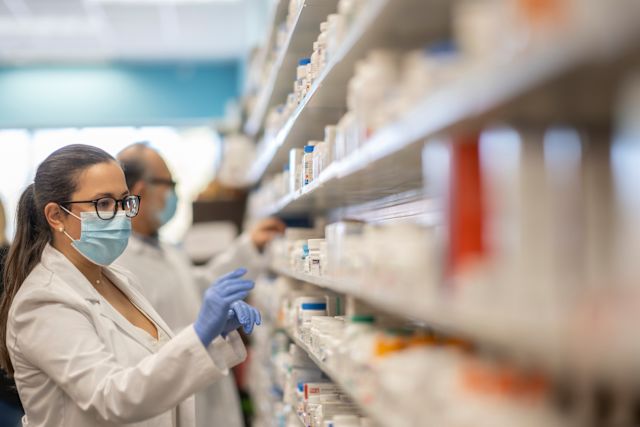Updated on October 8, 2025.
Though it is under review by the current presidential administration, the abortion pill for now remains available in most states. A June 2024 ruling from the United States Supreme Court effectively blocked a move by abortion opponents to roll back access to the drug, called mifepristone. The Court’s decision affirmed the authority of the U.S. Food and Drug Administration (FDA) to regulate drugs used in the United States, including vaccines.
Why access to the abortion pill was threatened
In June 2022, the Supreme Court overturned Roe v. Wade, the landmark ruling that made access to an abortion a federal right for Americans. In the decision’s wake, many states effectively banned abortion.
Months later, in November 2022, an anti-abortion group called the Alliance for Hippocratic Medicine initiated a lawsuit. It argued the FDA’s approval of mifepristone in 2000 was rushed and violated federal standards.
On April 7, 2023, a federal district court in Texas issued a decision that blocked the long-standing approval of the drug. In response, the U.S. Department of Justice immediately appealed the decision.
In August 2023, the New Orleans-based Fifth U.S. Circuit Court of Appeals ruled the FDA’s approval of mifepristone could remain in effect. But the court greatly limited the drug’s access by rolling back FDA updates made in 2016. Those updates had extended its use from weeks 7 to 10 of pregnancy and allowed it to be dispensed by mail, without the need for an office visit.
The ruling, however, did not take effect due to an emergency order from the Supreme Court in December 2023. The Supreme Court paused the lower court ruling, preserving the widespread availability of the abortion pill without restrictions while an appeal to the Supreme Court proceeded. Five of the nine justices agreed to grant the stay.
On June 13, 2024, the Supreme Court dismissed the case. It found the anti-abortion coalition who questioned the FDA’s decisions to ease access the pill did not have legal standing to sue. This ruling preserved access to mifespristone.
What is a medical abortion?
A medical abortion uses medication—not surgery or a procedure—to end an early pregnancy. Commonly known as the “abortion pill,” the drug mifepristone is given along with another medication called misoprostol.
Unlike Plan B (the “morning-after pill”), which may be used to block fertilization or prevent a fertilized egg from implanting in the uterus, mifepristone works by blocking the hormone progesterone. This causes the lining of the uterus to break down, which ends a pregnancy. The second drug, misoprostol, is taken up to 48 hours later. It causes the uterus to empty its content like a heavy, crampy period.
Those who take the pills must follow up with their healthcare provider roughly 7 to 14 days later to confirm the uterus is empty to avoid infection.
Restrictions would have blocked access to the drug
Mifepristone may be given along with misoprostol to end a pregnancy up to 10 weeks gestation (70 days or less since the first day of a person’s last menstrual period).
Rolling back the use of the drug to the first seven weeks of pregnancy would have had significant implications as many people do not realize they are pregnant by this point. A March 2022 study published in Contraception found that one in five people discover their pregnancy past seven weeks. The researchers noted that, in most cases, people who suspect they are pregnant take an at-home pregnancy test. Those that do find out that they are pregnant about one week earlier than those who go to a clinic, the study showed.
But young people, those who have never been pregnant before, and those with unplanned pregnancies were less likely to use these tests as a first step. Many young people also reported issues accessing at-home pregnancy tests, including not being able to get to a store or not having enough money to buy one.
People of color, people living with food insecurity, and people with unplanned pregnancies were also more likely to learn that they are pregnant past seven weeks.
Those with irregular menstrual periods are also less likely to know they are pregnant by seven weeks gestation because they cannot reliably determine when to expect their next period. A November 2021 study published in Proceedings of the National Academy of Sciences (PNAS), involving more than 267,000 people, found that 22 percent experienced irregular periods. Those more likely to be affected were younger people aged 18 to 24, as well as those with polycystic ovary syndrome (PCOS), type 2 diabetes, and certain hormone disorders. People who gave birth within the past year, Hispanic and non-Hispanic Black people were also more likely to experience irregular menstrual cycles.
During the COVID pandemic, the FDA announced that healthcare providers could become certified to prescribe mifepristone by completing a Prescriber Agreement Form. Before the drug regimen can be prescribed, however, patients and their healthcare provider must review and sign a Patient Agreement Form, acknowledging that the risks of the treatment regimen have been explained and are understood. Similarly, pharmacies must also be certified to dispense the drugs by completing a Pharmacy Agreement Form.
At that time, the FDA allowed the pills to be sent through the mail following telehealth appointments. On January 3, 2023, the in-person doctor’s visit requirement to access a medical abortion were removed. Had the appellate court ruling been upheld, three visits would have been required.
But is it effective—and safe?
The abortion pill is not new. The medication Mifeprex (the brand name for mifepristone) was first approved by the FDA in 2000. Years later, in 2019, the agency approved the first generic version of mifepristone. In 2020, medical abortion was used in 54 percent of all abortions in the United States, according to the Guttmacher Institute, a nonprofit focused on sexual and reproductive health and rights. A second generic version of mifepristone was approved in 2025.
Surgical abortions may be quicker, result in less bleeding, and more immediately ensure that all fetal tissue is removed from the uterus, reducing the risk for infection. But some people may prefer to avoid an invasive surgical procedure and anesthesia. Risks of surgery also include possible vaginal or cervical lacerations, as well as injury to the uterus, bowel, or bladder. Taking medications in private at home may also offer a greater sense of control and comfort.
The Texas lawsuit that went to the Supreme Court alleged that the FDA’s initial approval of mifepristone did not adequately review its safety risks. This was despite multiple decisions and scientific reviews by regulators over more than two decades. Since it was approved in 2000, mifepristone has been used by more than 5.6 million people, the FDA points out.
Medical abortions are highly effective, working between 95 and 99 percent of the time. They are considered to be safer than either surgical abortion or childbirth. In fact, a meta-analysis of 87 clinical trials including more than 45,000 people found that serious complications requiring hospitalization occurred in less than 0.3 percent of patients.
A 2019 analysis of FDA data conducted by the University of San Francisco Medical Center also found only 13 deaths possibly or probably related to medical abortion—a mortality rate of roughly 0.00035 percent.
Mifepristone is also used for the medical management of missed miscarriages—when the body doesn’t recognize the death of a fetus. It some cases, those who’ve experienced such a miscarriage may choose to avoid a dilation and curettage (D&C), a procedure that can be performed to remove tissue from inside the uterus and prevent infection. Potential D&C complications include uterine damage, scarring, and infection. A person may want to take medication to avoid these issues.
It may also be used to manage endometriosis or Cushing syndrome, which occurs when the body’s levels of the hormone cortisol are too high over time.
The FDA cautions, however, that purchasing mifepristone online or outside the United States from a provider or pharmacy that is not certified is risky, noting that it does not have oversight of prescription medicines outside the U.S. drug supply chain.
Some people should not take the abortion pill. It may be dangerous for those who:
- Are more than 11 weeks pregnant
- Have an ectopic pregnancy (a pregnancy outside of the uterus)
- Have an adrenal gland condition
- Are undergoing long-term corticosteroid therapy
- Have had an allergic reaction to mifepristone, misoprostol, or similar drugs
- Have bleeding problems or are taking medications to thin the blood
- Have a rare disorder called inherited porphyria
- Have an intrauterine device (IUD) in place
Within the first 24 hours of taking mifepristone and misoprostol, side effects may include nausea, cramping, spotting, headache, diarrhea, and dizziness. Symptoms that are more severe or do not resolve within 24 hours could be a sign of a more serious health concern. Complications are rare but may include severe bleeding and infection.
Those who experience the following symptoms after taking mifepristone and misoprostol should seek immediate medical attention:
- Heavy bleeding (enough to soak through two thick, full-size sanitary pads per hour for two consecutive hours)
- Abdominal pain or discomfort
- Fever of 100.4°F or higher that lasts for more than 4 hours
- Feeling sick, including weakness, nausea, vomiting, or diarrhea, with or without fever
These symptoms may be a sign of a serious infection or another problem, such as an ectopic pregnancy. If you are experiencing these warning signs and cannot immediately reach your healthcare provider, go to the nearest hospital emergency room.







